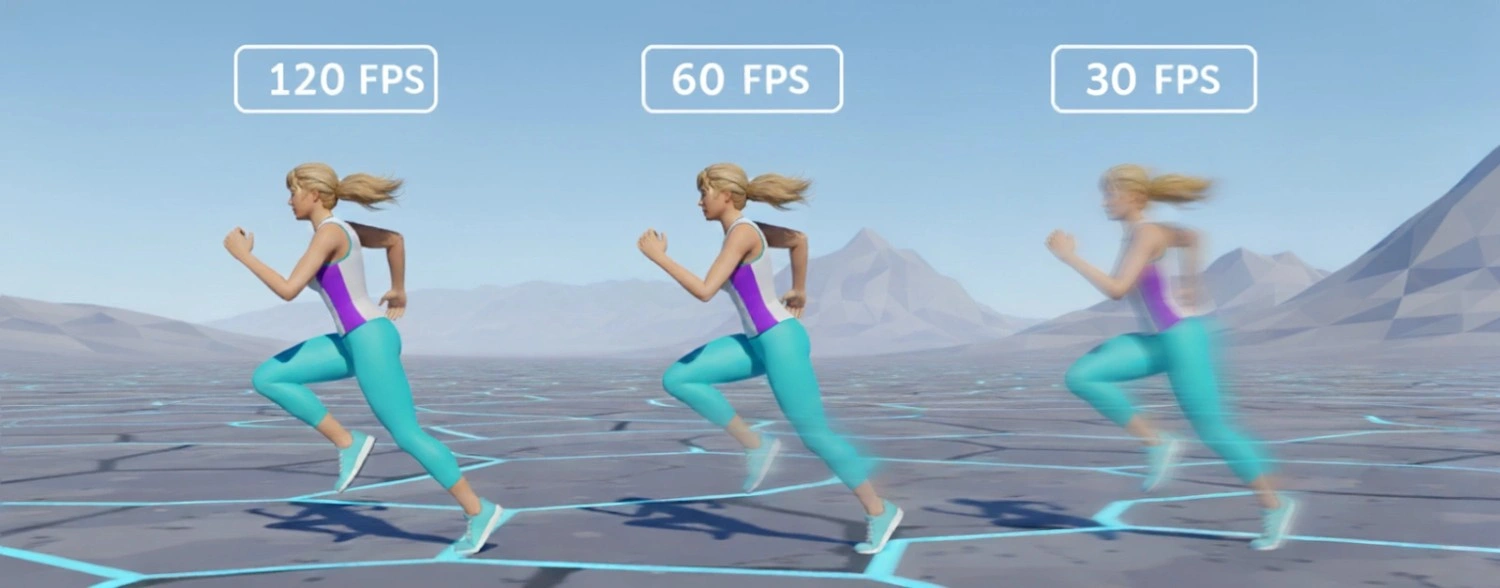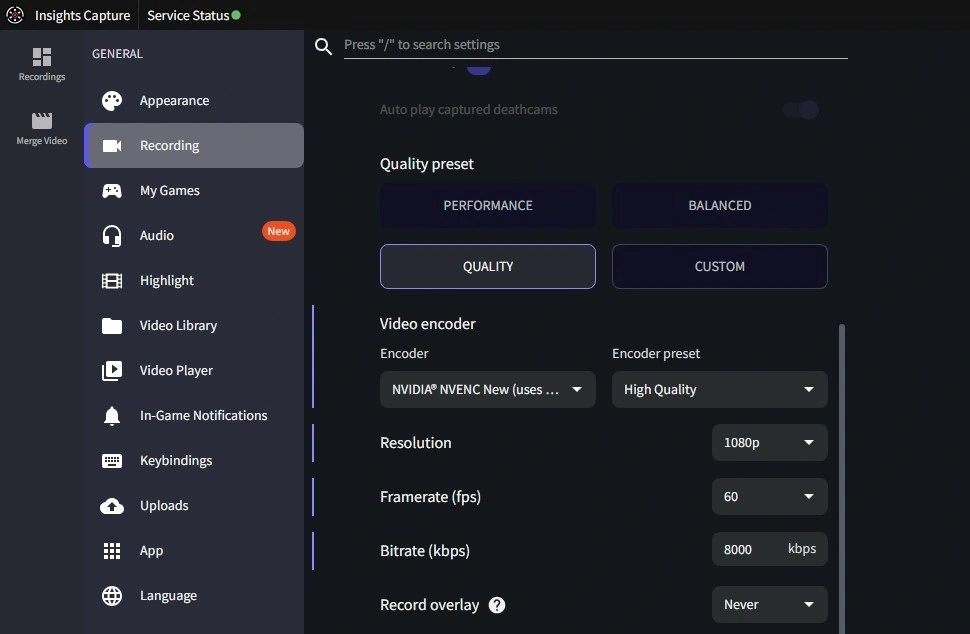What FPS Should I Record at Gaming: 30, 60, or 120 FPS Explained
Find out what FPS you should record at for gaming: 30, 60, or 120 FPS. This guide breaks down the differences, pros, and ideal use cases for each frame rate. Learn how Insights Capture helps you record smooth, high-quality gameplay at any FPS without lag or performance loss.
When it comes to recording gameplay, one of the most common questions players ask is what FPS should I record at gaming. Whether you’re creating YouTube content, streaming highlights, or reviewing your performance, the choice between 30, 60, or 120 FPS can significantly impact how smooth and immersive your footage looks. Here’s a breakdown of what FPS really means, how each option affects your recordings, and how to choose the right setting for your goals and setup.
What Does FPS Mean?
When deciding what FPS should I record at gaming and the best game recorder, it’s important to understand what FPS actually means. FPS, or frames per second, refers to how many images your recording software captures each second. A higher FPS results in smoother, more lifelike video, but it also demands more from your system in terms of processing power, storage, and bandwidth.
Here’s a quick breakdown:
- 30 FPS: Standard smoothness, often used for cinematic or casual content.
- 60 FPS: Double the fluidity, great for most gaming content.
- 120 FPS (and higher): Ultra-smooth and realistic, best for high-end setups and slow-motion edits.
Watch more: How to Record Roblox in High Quality While Keeping FPS Stable
What FPS Should I Record at Gaming?
Recording at 30 FPS
Recording at 30 FPS is the “classic” frame rate used in most standard video production. It provides a cinematic look that feels natural to watch and is ideal for systems that can’t handle high-performance recording. It’s also less demanding on your CPU and GPU, so you’ll experience fewer frame drops during gameplay.
30 FPS videos are also smaller in file size, which makes them easier to store, edit, and upload. While not as smooth as higher frame rates, they’re perfectly fine for story-based or slower-paced games where fluid motion isn’t a priority.
Best for:
- Story-driven or slower-paced games (RPGs, simulation, adventure titles)
- Players using older or mid-range PCs
- Creators who value stable performance over maximum smoothness
Pros:
- Low hardware demand
- Smaller file sizes
- Consistent playback on all platforms
Cons:
- Slightly choppy during fast motion
- Not ideal for shooters or competitive clips
Recording at 60 FPS
60 FPS is the gold standard for gaming content. It doubles the smoothness of 30 FPS, providing clear, crisp visuals that capture every movement precisely. This frame rate is perfect for competitive or action-heavy titles where fast motion is constant, such as Fortnite, VALORANT, Battlefield, Call of Duty, etc.
Because it looks great on both YouTube and Twitch, 60 FPS has become the go-to choice for most content creators. It balances quality, performance, and storage size effectively, giving your clips a professional finish without pushing your system to its limits.
Best for:
- Competitive and fast-paced games
- YouTubers, streamers, and highlight editors
- Gamers who want sharp, responsive-looking footage
Pros:
- Smooth, detailed motion
- Excellent for highlights and replays
- Widely supported by all major platforms
Cons:
- Larger files than 30 FPS
- Slightly heavier on system resources
Recording at 120 FPS (and Beyond)
Recording at 120 FPS offers the smoothest motion possible, capturing even the smallest movements with crystal clarity. It’s a favorite among advanced editors and esports professionals who rely on frame-by-frame accuracy for analysis or slow-motion sequences.
When exploring what FPS should I record at gaming, 120 FPS might seem like the ultimate choice for ultra-smooth visuals, and it is. However, it’s also far more demanding on your system, requiring powerful hardware, large storage capacity, and an editing setup that can handle massive files. Since most platforms like YouTube only support playback up to 60 FPS, recording at 120 FPS is best suited for professional projects or when you need extra flexibility during post-production.
Best for:
- Advanced creators and editors
- Esports players or analysts
- Slow-motion replays and cinematic content
Pros:
- Unmatched motion smoothness
- Perfect for detailed editing and slow-mo
- Future-ready for high-end productions
Cons:
- Extremely large file sizes
- Requires powerful hardware
- Overkill for casual gameplay capture
How to Choose the Right FPS When Recording Game

Choosing the right FPS depends on your goals, your hardware, and the type of content you create. Here’s a simple breakdown to help guide your choice:
- If you’re recording casually or telling stories: Go with 30 FPS. It looks good, takes less space, and won’t strain your PC. Perfect for playthroughs or commentary-based videos.
- If you’re creating YouTube or Twitch content: Choose 60 FPS. It’s the ideal balance between performance and smoothness, giving your footage a professional look while staying efficient.
- If you’re editing highlights or esports footage: Record at 120 FPS. You’ll get more flexibility in post-production, especially for slow-motion replays or detailed analysis.
- If your PC struggles with performance: Stick to 30 FPS to ensure your gameplay and recordings stay smooth without lag.
- If you have a high-end setup and love cinematic edits: Experiment with 120 FPS for ultra-detailed motion and creative effects.
Pro tip: Try to record at the same FPS your game runs at. For example, if your game runs at 60 FPS, record at 60 to keep playback smooth and synced.
Performance and Recording Software
Even with the right FPS, poor recording software can ruin great footage. Lag, dropped frames, and desyncs can all affect quality, especially when multitasking during gameplay. That’s why many creators rely on Insights Capture by Insights.gg.

If you’ve been wondering what FPS should I record at gaming, Insights Capture makes it easy to find the right balance. With adjustable presets like Performance, Balanced, and Quality, you can fine-tune your settings to match your PC’s power. Easily customize your encoder, resolution, FPS, and bitrate to achieve smooth performance and crisp, professional-looking visuals every time.
You can then review, clip, and share your highlights instantly, all from one platform. If you’re unsure which FPS runs best on your system, try testing different presets in Insights Capture to see what delivers the smoothest results for your setup.
See more: 10 Best Clipping Software That Doesn’t Affect FPS
Why Insights Capture Is the Best Tool for Recording at Any FPS
When it comes to deciding what FPS you should record at gaming, whether 30, 60, or 120 FPS, having the right tool makes all the difference. Many recorders can technically capture in high frame rates, but few can do it without lag, dropped frames, or complicated setup. That’s where Insights Capture by Insights.gg truly stands out.
{{button}}
Designed for gamers, streamers, and competitive players, Insights Capture combines powerful recording performance with ease of use. Featuring hardware acceleration, low system impact, and built-in editing, it’s an all-in-one solution for creating smooth, crystal-clear clips. Plus, its integrated VOD review tool lets you analyze every play frame by frame, making it perfect for improving performance and mastering your gameplay.
Key Benefits of Insights Capture
- Hardware-Accelerated Recording for Stable FPS: Insights Capture uses advanced GPU-based encoding to record your gameplay efficiently, keeping your FPS stable and responsive even during fast-paced action. Instead of overloading your CPU like traditional recorders, it distributes processing intelligently across your system for optimal performance.
- Always-On Capture and Instant Replay: Never miss a moment again. Insights Capture continuously records in the background and lets you instantly save your last few minutes of gameplay with Instant Replay. Whether it’s a perfect clutch, funny fail, or highlight-worthy moment, you can capture it in seconds without interrupting your game.
- Low CPU and GPU Usage: Unlike bulky recorders that drain your system, Insights Capture runs quietly in the background with minimal CPU and GPU consumption. This means smoother gameplay, no stutters, and no FPS drops, even during long recording sessions or high-resolution gaming.
- Custom FPS Control for Every Setup: Whether you prefer cinematic 30 FPS, smooth 60 FPS, or ultra-fluid 120 FPS, Insights Capture gives you complete control. You can easily adjust your recording settings to match your gameplay or content goals, ensuring every clip looks and feels exactly how you want.
- Built-In Editing and Sharing Tools: Once you finish recording, you don’t need third-party software to polish your footage. Trim, merge, or add annotations directly inside the Insights dashboard, then upload your highlights instantly to YouTube, TikTok, or Discord, all from one interface.
- VOD Review Tool for Performance Analysis: For competitive players and teams, the VOD Review tool is a game-changer. It lets you rewatch matches, break down plays frame by frame, and identify areas for improvement. This makes it perfect for esports teams, coaches, or creators who want to elevate their content and performance.
FAQs: What FPS Should I Record at Gaming
1. What FPS should I record gameplay at for YouTube?
60 FPS is ideal for YouTube, it delivers smooth, professional-quality footage that viewers expect from modern gaming content.
2. Does higher FPS mean better quality?
Not always. While 120 FPS looks ultra-smooth, most platforms only display up to 60 FPS, so balance quality with performance.
3. Can recording at 120 FPS cause lag?
Yes, if your hardware isn’t powerful enough. Use optimized software like Insights Capture to minimize FPS drops.
4. Is 30 FPS good enough for recording gameplay?
Yes, 30 FPS works fine for story-based or slow games, but fast-paced titles benefit from 60 FPS for smoother playback.
5. What’s the best FPS for competitive or esports gaming?
60 FPS or higher is ideal for competitive games, providing clarity and responsiveness that helps with precision and review.
Final Thoughts
If you’re wondering what FPS should I record at gaming, 60 FPS is the sweet spot, smooth, sharp, and ideal for most platforms. For casual sessions or lower-end setups, 30 FPS still delivers solid results, while 120 FPS caters to advanced creators who want ultra-detailed footage and slow-motion flexibility. No matter which option you choose, consistency matters most, stable, smooth recordings always outperform higher FPS plagued by lag or drops.
That’s exactly where Insights shines. It takes the guesswork out of recording, ensuring your clips stay sharp and smooth at any frame rate. Whether you’re chasing cinematic quality, esports-level precision, or quick highlight creation, Insights helps you record, review, and share your best gaming moments effortlessly. Contact us now!






.webp)